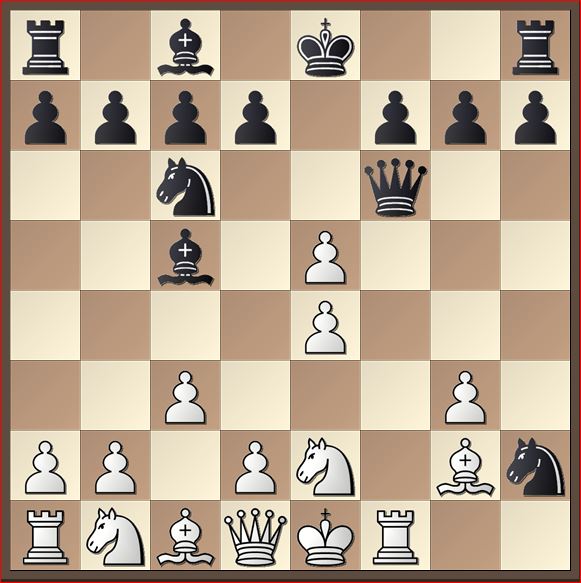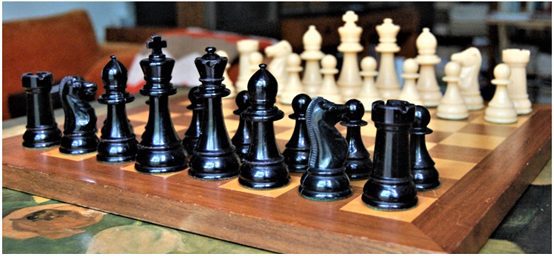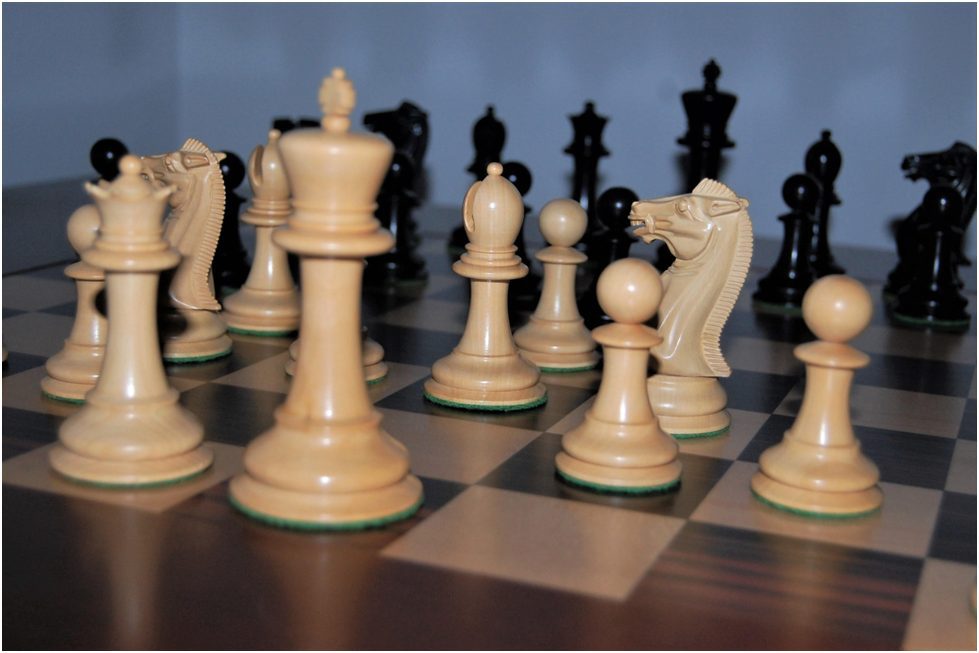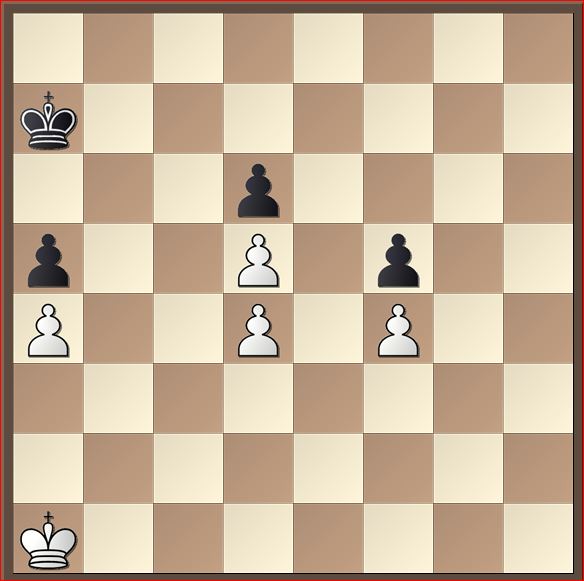NCCA officers
Charles Roberson - President John Timmel - First Vice President
Grant Oen - Scholastic Vice President
Wayne H. Spon - Secretary/Treasurer
Contributors
Roz Katz - Managing Editor
Dr. Walter High
Conrad Conero
Charles Roberson
John Timmel
Web support, edit, and distribution
John Timmel
John Timmel - First Vice President
Grant Oen - Scholastic Vice President
Wayne H. Spon - Secretary/Treasurer
Contributors
Roz Katz - Managing Editor
Dr. Walter High
Conrad Conero
Charles Roberson
John Timmel
Web support, edit, and distribution
John Timmel
NC Gambit, February 1, 2022

The above Zaria© “Keep it Simple,” was originally printed in February 2004 in Chess for Kids.
As a member of ncCHESS, you can expect to receive this publication on the first day of each month. Contents presented include: North Carolina chess news, games, cartoons and whatever. We welcome contributions from any members.
In this February issue of 2022, you will find:
- Roz’ View – with a blast from the past
- Conrad Conero – with a few pictures from his fabulous chess collection and photography.
- Walter High – Perspective
- Charles Roberson – The first of a series on Computer Chess
- John Timmel – “…to move and win!”
Roz’ View
Chess.com informs me that they currently have 75 million players.
I am playing on chesskid.com with my eight-year-old granddaughter every Thursday. They assigned me the name WildSneezyBubble, which I promptly changed. Who makes up these names, anyway?
GameKnot enables us to play intramural club games online, although we play in person on Monday evenings in Wake Forest. I am also on a team in Colorado, via GameKnot – Kermit the Frog invited me to join him, so what could I say???
Charles Pole (my husband) and I will be teaching ChessRefresh again in the OLLI Program at Duke, starting in April. Given the yoyo effect of the new and not improved Covid strain; I am reasonably sure that the schedule is cast firmly in silly-putty. Being an optimist, I have begun preparing for our abbreviated schedule.
33 consecutive years, except for 2021 [no thanks to Covid], Bruce Goodwin attended the “Land of the Sky” tournament in Asheville, NC.
In the beginning, Wilder Wadford, Jr. met with the five players who were members of the Asheville Chess Club proposing the idea of a National Tournament. They all agreed to invest in the promised $10,000 prize fund – until they found investment would disqualify them from competing in the tournament. They promptly withdrew from the investment, they all wanted to play!!!!
Only one year showed a loss, the year of the snowstorm.
Kevin J. Hyde is the spirit and chief Tournament Director of this annual event. 2022 was considered a success, with a turnout of 190 players.
There was an immediate sense of family. Everyone seemed to know one another and their love for chess was palpable. There were roughly five groups of local players, who were all in attendance. Surprising were the players from: CA, CT, FL, GA, PA, KY, LA, NM, SC, TN, TX, and VA; all made to feel welcome. One year there was even a player from Brazil.
Our GPS says the trip from Durham to Asheville is four hours. Going took us 5.5 hours, the return was 6.5 hours. My advice about planning for the trip: take the weather report and subtract 20 degrees. It is cold, cold, cold in those mountains. Gorgeous, but cold.
Make sure to schedule extra days to enjoy the spectacular mountains. We visited Biltmore and the Grove Park Inn. Our only regret was NOT playing.
RESULTS HERE
<Pictures to come>
Conrad Conero
“You might think that having an unlimited amount of time to analyze your moves such as you do in a correspondence game would lead to more perfect play. The following miniature may dissuade you of that belief since it occurred in just such a type of game.
Alapin’s Opening, Marko vs Jankovich, 1900, Correspondence, 1. e4, e5; 2. Ne2 (Alapin’s Opening, an uncommon move that initially blocks White’s bishop on f1. The idea however is often to play f4, similar to a King’s Gambit but without giving up the f-pawn), Bc5; 3. f4, Qf6; 4. c3, Nc6; 5. g3, Nh6; 6. Bg2, Ng4 (the threat is 7…, Nf2, winning the Exchange) 7. Rf1 (7.Qa4 was preferable), Nxh2; 8.fxe5? (expecting the Q to flee from the discovered attack by the R, but White gets a surprise – see diagram),
Jankovich

Marko
8.…., Qxf1+! (the proverbial “bolt from the blue”) Bxf1, Nf3 Mate!
Conrad is a prolific analyst, head of the North Durham Library Club, collector, and gifted photographer. We are displaying three of his photos below.

Above is a photo of my Windsor Castle Set, popular in the mid-20th century.
 This is a reproduction of the original 1849 Jaques Staunton set.
This is a reproduction of the original 1849 Jaques Staunton set.
 A rarely seen 5″ king-size Drueke “Imperial ” shown gracing my board.
A rarely seen 5″ king-size Drueke “Imperial ” shown gracing my board.
Walter High (wmhigh@nc.rr.com)
A Monthly Blog for North Carolina Chess Players
How do you study chess? – by Walter High (wmhigh@nc.rr.com)
All of us have a limited amount of time to devote to our chess game. The question for most people is: what is the best use of my time to improve my game? I have tried many different methods, but it has been hard to determine what works best for me. Since we are all individuals with different learning strategies and skills, there is probably no one method that will work as a general principle. Everyone has to experiment to learn what makes them most comfortable and also what seems to move them forward (in rating).
My first strategy grew out of having my sons work with a professional trainer. I watched the sessions and tried to learn from what they were taught. What I gained most from those sessions was a much better understanding of end game tactics and strategy. While this was useful, if I was never able get to the end game, that understanding never got an opportunity to manifest itself.
Working on my own, I decided to accumulate a chess book collection. This was easy to do because I was the owner of a used book store and just kept all the chess books I came across. I supplemented this by purchasing opening books for my sons to use with their trainer. Over the course of a decade, I grew my collection to nearly 800 books. Working from books I was able to study my openings in depth and rely on rote memorization to at least get to the middle game. I could often gain an advantage out of the opening, either a pawn up or a much better position, but that quickly dissipated in a complex middle game. There was also the problem of facing an opening that I had not studied. The unfamiliarity with the opening left me with some very quick losses or at best, a pretty terrible position to resolve.
On the advice of many players who either played against me or watched some of my games, I tried studying tactics because the phrase I heard the most was: “your tactics really suck!” The online site I have been using is Chess Tempo which allows free use of their tactical trainer. I put a lot of time into studying on this website and over the course of a year have completed over 7,000 tactical problems. I can see how this has helped, but still my OTB rating has declined over the past year or so. Some of this I attribute to the lack of tournaments and losing my familiarity with the OTB experience as opposed to playing randomly on a smaller online screen.
Lately, I have devoted significant time to what I should have been doing all along: thoroughly analyzing my games with a chess engine (supplemented by opening books) to see and hopefully understand where I have been going wrong. I had reviewed my games previously but was not as patient as I should have been, trying to rush through each game. Slowing down and devoting more time to analysis has been a success for me as I am gaining a better understanding of the positions I reach in my games. I don’t always understand why certain moves are better than others, but when I can get a fairly strong player (my son, primarily) to analyze the games, he can explain what I cannot figure out.
This last weekend in January I finally broke through a barrier: achieving an 1800+ rating on Lichess for classical chess games (longer time controls than bullet, blitz, and rapid). I believe this happened because I finally overcame my fear of just playing a lot. I think we all realize that you cannot improve your rating without actually playing! I have a friend who plays quite a bit almost every day (mostly blitz). He is a better player than me, but I have been gaining against him recently because I think a balanced approach combining all the above methods works best (at least for me). He never studies, he just plays a lot! The critical issue, of course, is time. We all have a limit to how much of it we can devote to chess. Each person needs to find their own comfort zone, but it seems that using only one method eventually leaves the wheels spinning.
I wish you all success in your quest to be a better chess player. There are probably study methods that work for you that I haven’t even thought of, but I wanted to review what I have experienced. Anyone’s feedback is greatly appreciated.
Charles Roberson
Training with Chess Computers and Chess Engines
In this article, I discuss using chess engines or chess computers for training. Chess computers refer to the old school dedicated computerized chess boards that were popular in the 1980s – 1990s and still exist. You can see some examples here USCF computer sales.
Some think that you shouldn’t train with chess engines/computers because the way they weaken themselves is too artificial and inhuman. This is only partially true. There is a way to train with computers. The modern way of weakening a chess AI came about around 10 years ago from some research that showed most games were lost by class players due to blunders. Also, the frequency of the blunders was inversely proportional to their rating. So, weak players blunder often and early while stronger players blunder less often and later. This is not a good method to train with.
There are other ways of weakening an AI that works for training. The two I prefer are time odds and forced search depths with the latter being my primary choice. With it, you tell the AI to keep its search depth at a fixed ply which could be as low as 1 ply or much higher. One-ply refers to a move. Two plies refer to a move and the opponent’s response. So, 1.e4 is one ply, and 1.e4 e5 is two plies. With this method, programs can play well on every move but with a limited search depth which weakens them. This method has several advantages:
- The clock may or may not be in use so you can play a slow game but the AI could be playing quickly.
- You can gradually increase the playing strength.
- You know just how shallow your thinking is when you make a mistake.
Generally, a program with a limited search of 1 ply has a playing strength around 1100 FIDE and each ply adds 100 – 150 Elo up to a point. I have used this technique with my program Ares to help players prepare for tournaments and they say it feels like playing a human. However, not all AIs allow limiting their search depths this way. Also, AIs will be somewhat stronger or weaker than the quoted strengths depending on certain options used in their programming. Thus, I suggest using Ares for this which I have online for free download at Ares chess engine download.
There is a slight catch to this: some highly tactical players may think the AI’s playing strength at each fixed ply is stronger while strategic/positional players disagree. This is due to the use of a quiescent search at the end of the normal search. At the end of a normal search, a computer will use a captures only search to find a quiet or “quiescent” position that is safe to statically evaluate. A quiet/quiescent position is one where neither side has any captures. With a quiescent search in use, a one ply search could find a mate in 3 if all moves are captures by both sides. Positional/strategic players tend to get their opponent into a bind before the killer blow which will not be seen by a quiescent search. However, such players will be punished for making a simple tactical error.
I’ve never seen exact testing and rating values for programs at fixed search depths and given that such ratings would vary from program to program I measured Ares. Over two thousand games were run with varied fixed depth versions of Ares against each other and AIs from the CCRL rating list that were only limited by the time control. I adjusted the CCRL blitz time control to match my laptop resulting in G/2 min 12 sec + 1.1 sec. After that, a program was run on the data to calculate ratings of the varied depth levels given the CCRL blitz ratings of the other programs. The results are as follows:
| Search Depth | Rating | Error +/- |
|---|---|---|
| Ares ply= 1 | 1101 | 74 |
| Ares ply= 2 | 1257 | 73 |
| Ares ply= 3 | 1343 | 70 |
| Ares ply= 4 | 1528 | 68 |
| Ares ply= 5 | 1647 | 67 |
| Ares ply= 6 | 1820 | 66 |
| Ares ply= 7 | 1918 | 69 |
| Ares ply= 8 | 2017 | 72 |
| Ares ply= 9 | 2070 | 73 |
| Ares ply= 10 | 2176 | 82 |
| Ares ply= 11 | 2268 | 92 |
To train with Ares, you will need the chess engine Ares and a GUI (Graphical User Interface) that supports the UCI (Universal Chess Interface) protocol. If you have any of the ChessBase engine GUIs such as Fritz that will work. If you need something free, I recommend SCID (Shane’s Chess Information Database) which can be downloaded here SCID download. It has been around since 1999 and is full featured and well tested.
You’ll have to install the GUI and “install” Ares into the GUI. Directions to install Ares into several GUIs (SCID, Arena, Chess Partner, Chess Assistant, Fritz) are at the download site for Ares: Ares chess engine download. A video on installing SCID and an AI can be found here SCID install and AI install.
Setting up a game with a fixed depth level in SCID:
- Bring up SCID
- Click Game then New Game
- Click Play
- Click Serious Game
- Choose engine Ares
- Pick an opening book like performance.bin
- Set the time for white/black
- Click the “Fixed depth” button and set the depth
- Click Play
Setting up a game with a fixed depth level in a Frtiz type commercial GUI:
- Bring up Fritz or another ChessBase engine GUI
- Click the Engine tab
- Click Change Main Engine
- Click on Ares
- Click the Home tab
- Click New Game
- Click Levels then Fixed Depth
- Choose a depth then click OK
- Make your moves
Also, SCID can be used to create and keep a database of your games. Now, start your AIs and get some practice in. Then go to the Land of the Sky chess tournament this weekend in Asheville. Entry info here: Land of the Sky chess tournament.
John Timmel
“…to move and win!”
White to move wins, Black to move draws

Solution next month
Post your answers in the “…to move and win” topic under the NC Chess Forums
Best of luck – John